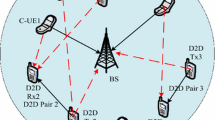Abstract
Device-to-device (D2D) communication enables direct communication among users in close proximity, bypassing the core network. With relay assistance, D2D users can have the leverage of transmitting data directly over long distances with increased throughput. However, due to dynamic nature of wireless networks, there may be uncertainty in the channel parameters known to a user. In this paper, the authors address the joint problem of relay selection and optimal power allocation in single-source multi-relay D2D networks when the perfect channel state information for relay channels is unknown. The uncertainty has been modeled as a bounded difference between actual and nominal values. An incentive-based robust Stackelberg game is proposed in which the relay devices determine the price of power allocated to them by the source device. A closed form expression for the optimal power was obtained. Further, the Stackelberg equilibrium was derived and its existence and uniqueness was demonstrated. The performance of the proposed game with the nominal game was compared. Simulation results confirm the effectiveness of the robust game-theoretic solution in an incomplete information environment.





Similar content being viewed by others
References
Bangerter, B., Talwar, S., Arefi, R., & Stewart, K. (2014). Networks and devices for the 5G era. IEEE Communications Magazine,52(2), 90–96.
Lin, X., Andrews, J., Ghosh, A., & Ratasuk, R. (2014). An overview of 3GPP device-to-device proximity services. IEEE Communications Magazine,52(4), 40–48.
Boccardi, F., Heath, R. W., Lozano, A., Marzetta, T. L., & Popovski, P. (2014). Five disruptive technology directions for 5G. IEEE Communications Magazine,52(2), 74–80.
Lamba, A. K., Kumar, R., & Sharma, S. (2018). A coalitional game-based integrated framework for optimal power allocation in multirelay cooperative environment. International Journal of Communication Systems,31(1), e3409.
Raghothaman, B., Sternberg, G., Kaur, S., Pragada, R., Deng, T., & Vanganuru, K. (2011). System architecture for a cellular network with cooperative mobile relay. In IEEE vehicular technology conference (pp. 1–5).
Ma, X., Yin, R., Yu, G., & Zhang, Z. (2012). A distributed relay selection method for relay assisted device-to-device communication system. In IEEE 23rd international symposium on personal indoor and mobile radio communications (pp. 1020–1024).
Lee, D., Kim, S. I., Lee, J., & Heo, J. (2012). Performance of multihop decode-and-forward relaying assisted device-to-device communication underlaying cellular networks. In IEEE international symposium on information theory and its applications (pp. 455–459).
Bauso, D. (2016). Game theory with engineering applications. Philadelphia: SIAM.
Kumar, R. (2013). Game theoretic pattern analysis for identification of odors/gases using response of a poorly selective sensor array. IEEE Sensors Journal,13(3), 1110–1116.
MacKenzie, A. B., & DaSilva, L. A. (2006). Game theory for wireless engineers. San Rafael: Morgan & Claypool Publisher.
Liang, X., Chen, M., & Leung, V. (2011). A game-theoretic approach for relay assignment over distributed wireless networks. Wireless Communications and Mobile Computing,11(12), 1646–1656.
Huang, J., Han, Z., Chiang, M., & Poor, H. V. (2008). Auction-based resource allocation for multi-relay asynchronous cooperative networks. In IEEE international conference on acoustics, speech and signal processing (pp. 5356–5359).
Yin, R., Zhong, C., Yu, G., Zhang, Z., Wong, K. K., & Chen, X. (2016). Joint spectrum and power allocation for D2D communications underlaying cellular networks. IEEE Transactions on Vehicular Technology,65(4), 2182–2195.
Lyu, J., Chew, Y. H., & Wong, W. C. (2016). A Stackelberg game model for overlay D2D transmission with heterogeneous rate requirements. IEEE Transactions on Vehicular Technology,65(10), 8461–8475.
Zhang, Y., Xu, Y., Gao, M., Zhang, Q., Li, H., Ahmad, I., & Feng, Z. (2015). Resource management in device-to-device underlaying cellular network. In IEEE wireless communications and networking conference (pp. 1631–1636).
Della Penda, D., Abrardo, A., Moretti, M., & Johansson, M. (2016). Potential games for subcarrier allocation in multi-cell networks with D2D communications. In IEEE International Conference on Communications (pp. 1-6).
Zhong, W., Fang, Y., Jin, S., Wong, K. K., Zhong, S., & Qian, Z. (2015). Joint resource allocation for device-to-device communications underlaying uplink MIMO cellular networks. IEEE Journal on Selected Areas in Communications,33(1), 41–54.
Wang, F., Xu, C., Song, L., & Han, Z. (2015). Energy-efficient resource allocation for device-to-device underlay communication. IEEE Transactions on Wireless Communications,14(4), 2082–2092.
Wu, D., Wang, J., Hu, R. Q., Cai, Y., & Zhou, L. (2014). Energy-efficient resource sharing for mobile device-to-device multimedia communications. IEEE Transactions on Vehicular Technology,63(5), 2093–2103.
Li, Y., Jin, D., Yuan, J., & Han, Z. (2014). Coalitional games for resource allocation in the device-to-device uplink underlaying cellular networks. IEEE Transactions on Wireless Communications,13(7), 3965–3977.
Wu, D., Cai, Y., Hu, R. Q., & Qian, Y. (2015). Dynamic distributed resource sharing for mobile D2D communications. IEEE Transactions on Wireless Communications,14(10), 5417–5429.
Mallick, S., Rashid, M. M., & Bhargava, V. K. (2012). Joint relay selection and power allocation for decode-and-forward cellular relay network with channel uncertainty. IEEE Transactions on Wireless Communications,11(10), 3496–3508.
Hasan, M., Hossain, E., & Kim, D. I. (2014). Resource allocation under channel uncertainties for relay-aided device-to-device communication underlaying LTE-A cellular networks. IEEE Transactions on Wireless Communications,13(4), 2322–2338.
Ng, C. Y., Lok, T. M., & Wong, T. F. (2010). Pricing games for distributed cooperative transmission. IEEE Transactions on Vehicular Technology,59(7), 3393–3406.
Laneman, J. N., Tse, D. N., & Wornell, G. W. (2004). Cooperative diversity in wireless networks: Efficient protocols and outage behavior. IEEE Transactions on Information Theory,50(12), 3062–3080.
Ben-Tal, A., & Nemirovski, A. (1998). Robust convex optimization. Mathematics of Operations Research,23(4), 769–805.
Aghassi, M., & Bertsimas, D. (2006). Robust game theory. Mathematical Programming,107(1–2), 231–273.
Wang, B., Han, Z., & Liu, K. R. (2009). Distributed relay selection and power control for multiuser cooperative communication networks using stackelberg game. IEEE Transactions on Mobile Computing,8(7), 975–990.
Author information
Authors and Affiliations
Corresponding author
Additional information
Publisher's Note
Springer Nature remains neutral with regard to jurisdictional claims in published maps and institutional affiliations.
Rights and permissions
About this article
Cite this article
Lamba, A.K., Kumar, R. & Sharma, S. A Robust Stackelberg Game Approach for Joint Relay Selection and Optimal Power Allocation for Cooperative Device-to-Device Communication Under Channel Uncertainties. Wireless Pers Commun 110, 169–183 (2020). https://doi.org/10.1007/s11277-019-06718-y
Published:
Issue Date:
DOI: https://doi.org/10.1007/s11277-019-06718-y




